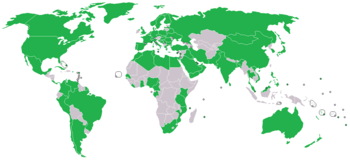
The (International) Radiotelephony Spelling Alphabet, commonly known as the NATO phonetic alphabet, is the most widely used set of clear code words for communicating the letters of the Roman alphabet. Technically a radiotelephonic spelling alphabet, it goes by various names, including NATO spelling alphabet, ICAO phonetic alphabet and ICAO spelling alphabet. The ITU phonetic alphabet and figure code is a rarely used variant that differs in the code words for digits.

An emergency position-indicating radiobeacon (EPIRB) is a type of emergency locator beacon for commercial and recreational boats, a portable, battery-powered radio transmitter used in emergencies to locate boaters in distress and in need of immediate rescue. In the event of an emergency, such as a ship sinking or medical emergency onboard, the transmitter is activated and begins transmitting a continuous 406 MHz distress radio signal, which is used by search-and-rescue teams to quickly locate the emergency and render aid. The signal is detected by satellites operated by an international consortium of rescue services, COSPAS-SARSAT, which can detect emergency beacons anywhere on Earth transmitting on the distress frequency of 406 MHz. The satellites calculate the position or utilize the GPS coordinates of the beacon and quickly passes the information to the appropriate local first responder organization, which performs the search and rescue. As Search and Rescue approach the search areas, they use Direction Finding (DF) equipment to locate the beacon using the 121.5 MHz homing signal, or in newer EPIRBs, the AIS location signal. The basic purpose of this system is to help rescuers find survivors within the so-called "golden day" during which the majority of survivors can usually be saved. The feature distinguishing a modern EPIRB, often called GPIRB, from other types of emergency beacon is that it contains a GPS receiver and broadcasts its position, usually accurate within 100 m (330 ft), to facilitate location. Previous emergency beacons without a GPS can only be localized to within 2 km (1.2 mi) by the COSPAS satellites and relied heavily upon the 121.5 MHz homing signal to pin-point the beacons location as they arrived on scene.
The Global Maritime Distress and Safety System (GMDSS) is a worldwide system for automated emergency signal communication for ships at sea developed by the United Nations' International Maritime Organization (IMO) as part of the SOLAS Convention.

The European Telecommunications Satellite Organization is an intergovernmental organisation consisting of 49 member states. It is headquartered in Paris, France. The mission of EUTELSAT IGO is to maintain the rights to use radio frequencies and orbital locations which were assigned collectively to the Member States by the International Telecommunication Union (ITU) and to oversee the operations of Eutelsat S.A. so as to ensure that the company complies with the international EUTELSAT Convention. EUTELSAT IGO plays an active role within the global telecommunications community and is a key actor in the satellite business sector.
A Maritime Mobile Service Identity (MMSI) is effectively a maritime object's international maritime telephone number, a temporarily assigned UID, issued by that object's current flag state.
COMSAT is a global telecommunications company based in the United States.
The Future Air Navigation System (FANS) is an avionics system which provides direct data link communication between the pilot and the air traffic controller. The communications include air traffic control clearances, pilot requests and position reporting. In the FANS-B equipped Airbus A320 family aircraft, an Air Traffic Services Unit (ATSU) and a VHF Data Link radio (VDR3) in the avionics rack and two data link control and display units (DCDUs) in the cockpit enable the flight crew to read and answer the controller–pilot data link communications (CPDLC) messages received from the ground.

Inmarsat is a British satellite telecommunications company, offering global mobile services. It provides telephone and data services to users worldwide, via portable or mobile terminals which communicate with ground stations through fourteen geostationary telecommunications satellites.

Boeing 702 is a communication satellite bus family designed and manufactured by the Boeing Satellite Development Center, and flown from the late-1990s into the 2020s. It covers satellites massing from 1,500 kg (3,300 lb) to 6,100 kg (13,400 lb) with power outputs from 3 to 18 kW and can carry up to approximately 100 high-power transponders.

Vessel Monitoring Systems (VMS) is a general term to describe systems that are used in commercial fishing to allow environmental and fisheries regulatory organizations to track and monitor the activities of fishing vessels. They are a key part of monitoring control and surveillance (MCS) programs at national and international levels. VMS may be used to monitor vessels in the territorial waters of a country or a subdivision of a country, or in the Exclusive Economic Zones (EEZ) that extend 200 nautical miles (370.4 km) from the coasts of many countries. VMS systems are used to improve the management and sustainability of the marine environment, through ensuring proper fishing practices and the prevention of illegal fishing, and thus protect and enhance the livelihoods of fishermen.
COMSAT Mobile Communications (CMC) is a telecommunications company which provides global mobile communications solutions to the maritime, land mobile and aeronautical communities, and offers data, voice, fax, telex and video capabilities via the Inmarsat geosynchronous satellite constellation through two earth station facilities in Southbury, Connecticut, and Santa Paula, California. CMC was a business unit of COMSAT Corporation of Bethesda, MD (delisted).
SkyWave Mobile Communications is a global provider of satellite and satellite-cellular devices in the Machine-to-Machine (M2M) market. SkyWave's products allow customers to track, monitor and control industrial vehicles, vessels and industrial equipment. Applications include tracking the location of vehicle fleets, monitoring data from oil and gas flowmeters and pumps turning on and off.

The Directorate General of Civil Aviation (DGCA) is a statutory body of the Government of India to regulate civil aviation in India. It became a statutory body under the Aircraft (Amendment) Act, 2020. The DGCA investigates aviation accidents and incidents, maintains all regulations related to aviation and is responsible for issuance of licenses pertaining to aviation like PPL's, SPL's and CPL's in India. It is headquartered along Sri Aurobindo Marg, opposite Safdarjung Airport, in New Delhi. The Government of India is planning to replace the organisation with a Civil Aviation Authority (CAA), modelled on the lines of the American Federal Aviation Administration (FAA).
A hosted payload is a module attached to a commercial satellite with communications circuitry that operates independently of the main spacecraft but which shares the satellite's power supply and transponders. The concept has been also been referred to as "piggybacking" or "hitchhiking."
Vizada is a worldwide satellite communications service provider which operates earth ground stations that connect satellite communications to terrestrial telecommunications and IP networks. Vizada provides both mobile and fixed satellite telecommunications to a wide array of markets including merchant shipping, defense and government, fishing and yachting, oil and gas, mining, and non-governmental organizations. The product offering covers maritime, land, and aeronautical services. In 2011, the Vizada Group was acquired by EADS, to be integrated as a subsidiary of Astrium.

Steven Lett is a former American diplomat and current chief executive of the International Cospas-Sarsat Programme in Montreal, Quebec, Canada.
Kymeta Corporation is a satellite communications company based in the United States. It was founded in August 2012 after spinning out from Intellectual Ventures and manufactures software-enabled, meta-materials based electronic beamforming antennas and terminals for satellite communications.
Aviation English is the de facto international language of civil aviation. With the expansion of air travel in the 20th century, there were safety concerns about the ability of pilots and air traffic controllers to communicate. In 1951, the International Civil Aviation Organization (ICAO) recommended in "ICAO Annex 10 ICAO to the International Chicago Convention" that English be universally used for "international aeronautical radiotelephony communications." Despite being a recommendation only, ICAO aviation English was widely accepted.
Olof Ingemar Lundberg was a Swedish business executive and a prominent figure in the mobile satellite services industry. He served as founding Director General and then CEO of Inmarsat, a non-profit intergovernmental organisation created to establish and operate a satellite communications network for the maritime community, from 1979 to 1995; founding Chairman and CEO of ICO Global Communications 1995-2000; and Chairman and CEO of Globalstar 2001-2003.









